Current events
Next talk on Tuesday in 2 days by Dursun Tosuncuk.
News 10.07.2025
New publication: Phonon-limited valley lifetimes in single-particle bilayer graphene quantum dots
Site Content:
10.09.2015
New publication: Back action of graphene charge detectors on graphene and carbon nanotube quantum dots
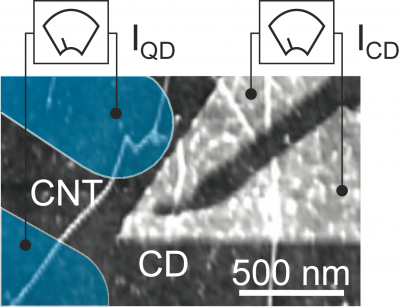
Physica Status Solidi B 252, 2461 (2015)
We report on devices based on graphene charge detectors (CDs) capacitively coupled to graphene and carbon nanotube quantum dots (QDs). We focus on back action effects of the CD on the probed QD. A strong influence of the bias voltage applied to the CD on the current through the QD is observed. Depending on the charge state of the QD, the current through the QD can either strongly increase or completely reverse as a response to the applied voltage on the CD. To describe the observed behavior, we employ two simple models based on single electron transport in QDs with asymmetrically broadened energy distributions of the source and the drain leads. The models successfully explain the back action effects. The extracted distribution broadening shows a linear dependency on the bias voltage applied to the CD. We discuss possible mechanisms mediating the energy transfer between the CD and QD and give an explanation for the origin of the observed asymmetry.

08.09.2015
Institute Trip 2015: Waterski in Langenfeld
Our institute trip of the 2nd Institute of Physics on the 4th of September 2015 was a great success.
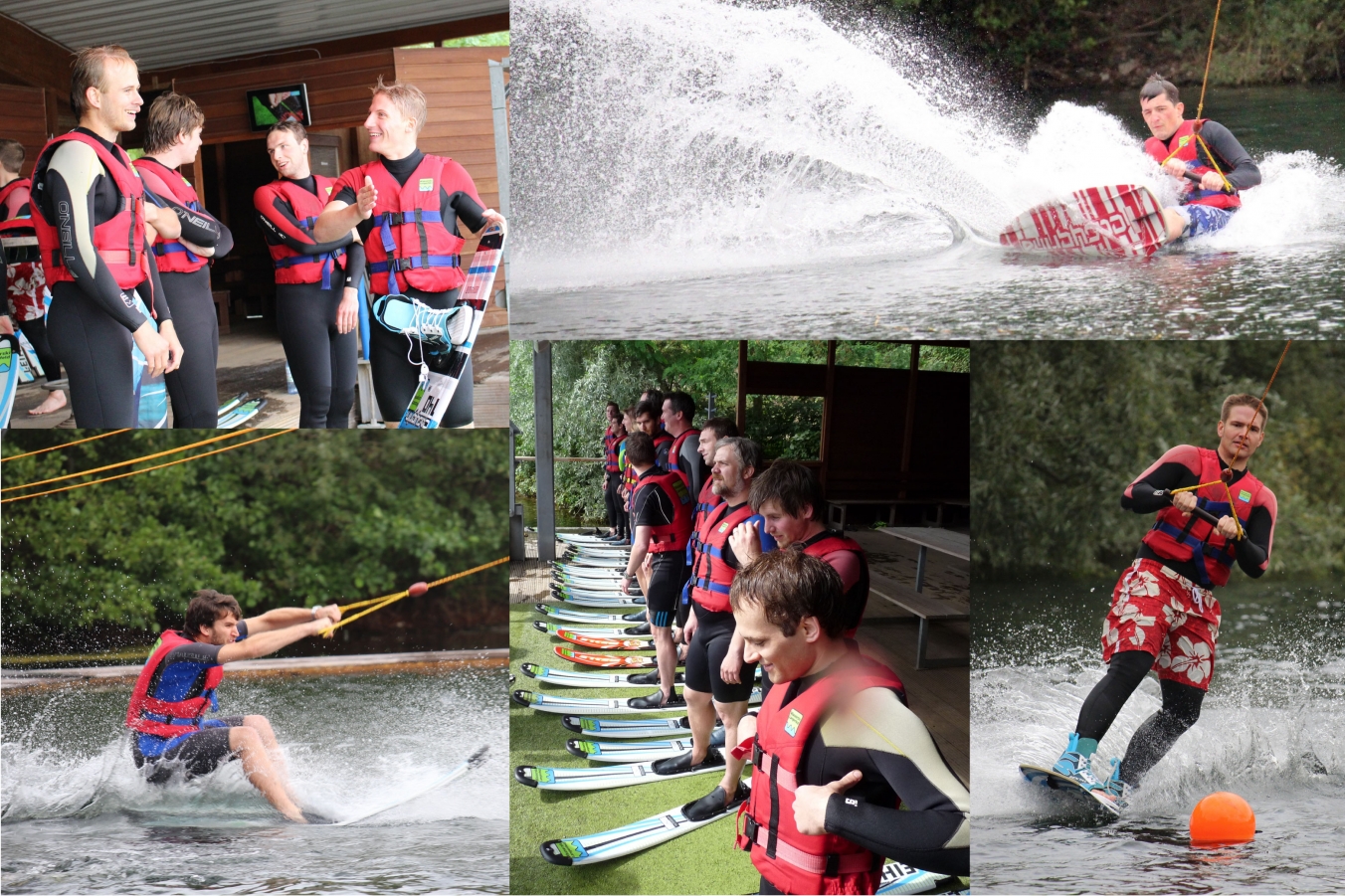

04.09.2015
WEF Annual Meeting New Champions 2015
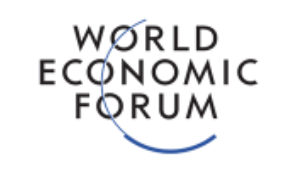
Christoph Stampfer is invited as "Young Scientists" to the World Economic Forum’s (WEF) Annual Meeting of the New Champions, Global Summit on Innovation, Science and Technology.
For more information please see:
www.weforum.org/events/annual-meeting-new-champions-2015.
For the ERC press release please see:
erc.europa.eu/media-and-events/events/annual-meeting-new-champions-2015.

27.08.2015
New publication: Nanosecond spin lifetimes in bottom-up fabricated bilayer graphene spin-valves with atomic layer deposited Al2O3 spin injection and detection barriers
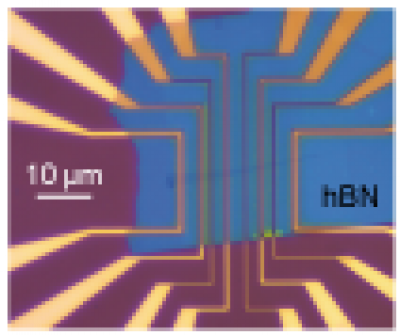
Physica Status Solidi B (online)
We present spin transport studies on bi- and trilayer graphene
non-local spin-valves which have been fabricated by a bottomup
fabrication method. By this technique, spin injection electrodes
are first deposited onto Si++/SiO2 substrates with subsequent
mechanical transfer of a graphene/hBN heterostructure.
We showed previously that this technique allows for nanosecond
spin lifetimes at room temperature combined with carrier
mobilities which exceed 20,000 cm2Vs)−1. Despite strongly
enhanced spin and charge transport properties, the MgO injection
barriers in these devices exhibit conducting pinholes which
still limit the measured spin lifetimes.We demonstrate that these
pinholes can be partially diminished by an oxygen treatment of
a trilayer graphene device which is seen by a strong increase of
the contact resistance area products of the Co/MgO electrodes.
At the same time, the spin lifetime increases from 1 to 2 ns.We
believe that the pinholes partially result from the directional
growth in molecular beam epitaxy. For a second set of devices,
we therefore used atomic layer deposition of Al2O3 which offers
the possibility to isotropically deposit more homogeneous barriers.
While the contacts of the as-fabricated bilayer graphene
devices are non-conductive, we can partially break the oxide
barriers by voltage pulses. Thereafter, the devices also exhibit
nanosecond spin lifetimes.

21.08.2015
Sowmya Somanchi wins the „Falling Walls Lab Jülich“ competition
Sowmya Somanchi wins the 2015 „Falling Walls Lab Jülich“ competition. Under the slogan "Great Minds - 3 Minutes - 1 Day" 15 young scientsits did their best to convince the jury by a 3 minunts talk on their own research topic. Sowmya is now invited to the "Falling Walls Conference" on the 8th und 9th November in Berlin.
For more information please see:
Pressemitteilung Forschungszentrum Jülich.
Alexander Braun (1.v.l.), Sowmya Somanchi (2.v.l.) und Moritz Nabel (rechts) fahren zum Finale und zur "Falling Walls Conference" nach Berlin. Prof. Wolfgang Marquardt (2.v.r.), Vorstandsvorsitzender des Forschungszentrums, war Mitglied der Jury des ersten "Falling Walls Lab Jülich".
Copyright: Forschungszentrum Jülich.
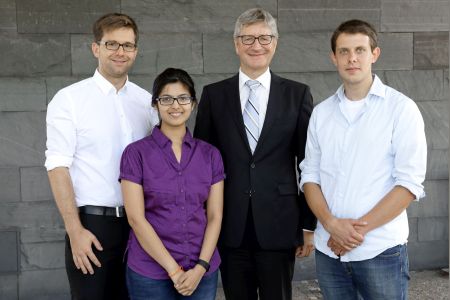

20.08.2015
"High-quality delamination" - Research Highlights, Nature Materials, 14, 857 (2015)
Our recent work published in Science Advances has been highlighted by Nature Materials: "High-quality delamination" - Research Highlights, Nature Materials 14, 857 (2015).

17.08.2015
New publication: Phase-coherent transport in catalyst-free vapor phase deposited Bi2Se3 crystals
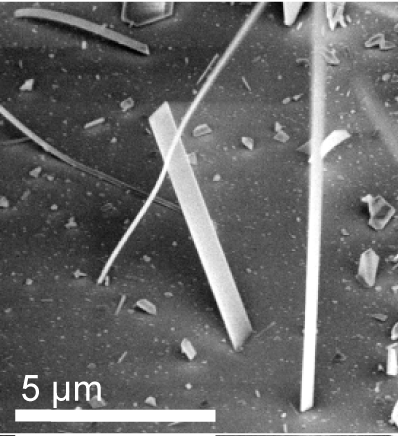
Phys. Rev. B 92, 085417 (2015)
Freestanding Bi2Se3 single-crystal flakes of variable thicknesses are grown using a catalyst-free vapor-solid synthesis and are subsequently transferred onto a clean Si++/SiO2 substrate where the flakes are contacted in Hall bar geometry. Low-temperature magnetoresistance measurements are presented which show a linear magnetoresistance for high magnetic fields and weak antilocalization (WAL) at low fields. Despite an overall strong charge-carrier tunability for thinner devices, we find that electron transport is dominated by bulk contributions for all devices. Phase-coherence lengths lϕ as extracted from WAL measurements increase linearly with increasing electron density exceeding 1μm at 1.7 K. Although lϕ is in qualitative agreement with electron-electron interaction-induced dephasing, we find that spin-flip scattering processes limit lϕ at low temperatures.

14.08.2015
Poster prize for Luca Banszerus at Carbonhagen 2015
Luca Banszerus won with his contribution on "High mobility and ballistic transport in graphene by chemical vapor deposition" the Poster prize at the Carbonhagen 2015 in Kopenhagen (Dänemark).

